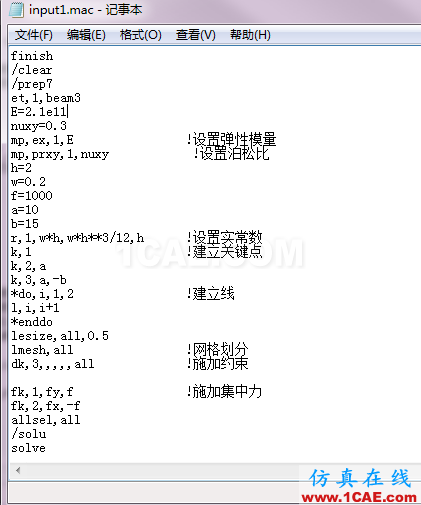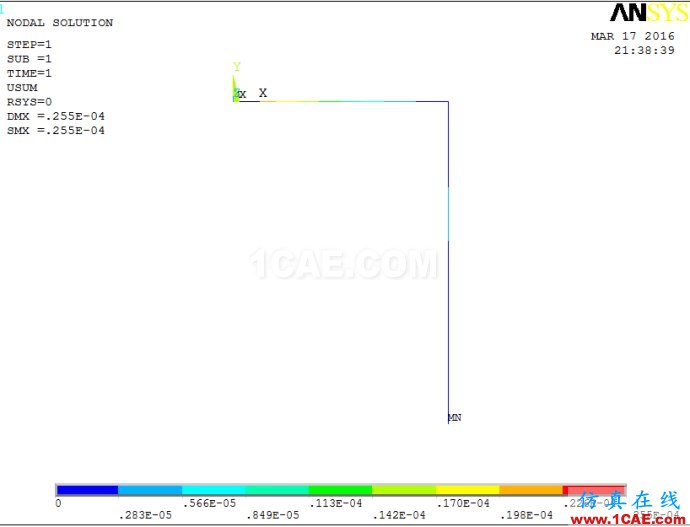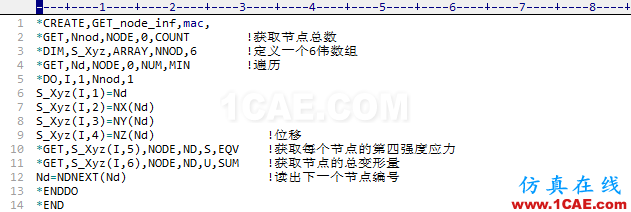APDL实现ANSYS的结果或中间变量值打印输出到txt文件
2017-05-26 by:CAE仿真在线 来源:互联网
APDLAPDL实现ANSYS的结果或中间变量值打印输出到文件
总结重点如下:
1、apdl运行过程中的数据(包括节点,位置,函数返回值,变量等)通过vwrite输出到txt文件
2、使用命令相关命令:vwrite,mwrite,cfopen,cfclos,/output等
output本来是写standard output的,即那个黑窗口,但也可以通过这个命令改为写到文件,vwrite就是把变量数组写到output
如果不想与标准输出窗口那些内容相互混合,你可以通过cfopen,cfclos来建立独立的文件,然后通过vwrite写入
*VWRITE, Par1, Par2, Par3, Par4, Par5, Par6, Par7, Par8, Par9, Par10, Par11, Par12, Par13, Par14, Par15, Par16, Par17, Par18, Par19
Writes data to a file in a formatted sequence.
APDL: Array Parameters
MP ME ST PR PRN <> EM DY PP EME MFS
Argument Descriptions
Par1, Par2, Par3, . . . , Par19
You can write up to 19 parameters (or constants) at a time. Any Par values after a blank Par value are ignored. If you leave them all blank, one line will be written (to write a title or a blank line). If you input the keyword SEQU, a sequence of numbers (starting from 1) will be written for that item.
Notes
You use *VWRITE to write data to a file in a formatted sequence. Data items (Par1, Par2, etc.) may be array parameters, scalar parameters, character parameters (scalar or array), or constants. You must evaluate expressions and functions in the data item fields before using the *VWRITE command, since initially they will be evaluated to a constant and remain constant throughout the operation. Unless a file is defined with the *CFOPEN command, data is written to the standard output file. Data written to the standard output file may be diverted to a different file by first switching the current output file with the /OUTPUT command. You can also use the *MWRITE command to write data to a specified file. Both commands contain format descriptors on the line immediately following the command. The format descriptors can be in either Fortran or C format.
/OUTPUT, Fname, Ext, --, Loc
Redirects text output to a file or to the screen.
1 概述
ANSYS作为通用有限元仿真计算软件应用非常普遍,其强大的参数化功能更是使得ANSYS的使用方便很多。在计算过程中,通常需要对计算结果进行统计,ANSYS计算的模型大多时候节点单元数目很多,结果数据也很多,因此在GUI界面的查询操作不太方便,工作量太大,而且结果不好记录。而且很多时候需要借助第三方软件比如MATLAB等数据处理软件对结果进行处理,此情况下需要ANSYS能够将计算结果输出到文件中,再通过对结果文件进行处理得到想要的结果。
APDL不仅在参数化建模、加载和求解有很大的发挥,在后处理时同样有发挥。本次借助APDL编写后处理命令流,将需要的计算结果以设置好的格式输出为txt文件。
2 应用
将编写好的前处理和求解APDL命令流在ANSYS里面运行,命令流文件如图1所示,该段命令流为两根梁的求解计算,如图2所示。

图1 前处理与求解APDL命令流

图2 模型
首先将所有节点的坐标位置输出,命令流如图3所示。

图3 输出节点位移APDL命令流
ANSYS还可以将结果保存为数组,如图4所示,数组可以仿照图3的循环部分输出,数组中的数据可以继续在ANSYS里面反复调用。

图4 输出数组
同样的,其他的结果参数也可以输出。如图5所示,为节点应力结果的输出。

图5
APDL获取其他的结果
基本思路是通过循环语句获取所有节点的参量,保存成数组,也可以不保存,然后新建一个文件用于输出节点的参量,主要的命令是*CREATE和*GET。
本文转发自http://blog.sina.com.cn/s/blog_6465f2ed0102wzvz.html
相关标签搜索:APDL实现ANSYS的结果或中间变量值打印输出到txt文件 Ansys有限元培训 Ansys workbench培训 ansys视频教程 ansys workbench教程 ansys APDL经典教程 ansys资料下载 ansys技术咨询 ansys基础知识 ansys代做 Fluent、CFX流体分析 HFSS电磁分析 Abaqus培训






